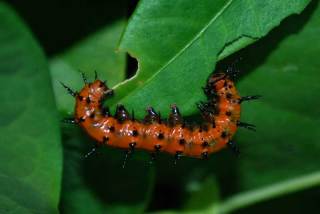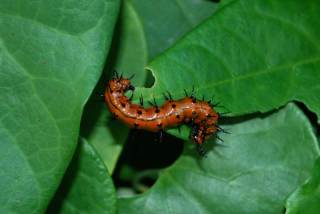A couple of weeks ago (December 2, actually), I happened to be outside and found this larva of Agraulis vanillae, the beautiful Gulf Fritillary, on our maypop (passiflora) vine. I can’t get over how those little feet work so well to keep these guys attached to whatever they’re clinging to at the moment.
Seeing this caterpillar was a bit of a surprise, because most of that entire fence on the side of the house is covered with a very aggressive Aristolochia vine that these fritillary caterpillars can’t eat. But way back when we planted, we had two (or maybe it was three?) of these native passiflora vines, and only one of the exotic Dutchman’s pipe. Even in the detail photos, the larger leaves of the exotic vine are easy to spot; it’s pretty hard to tell that the caterpillar is happily munching on its food in and among all that foliage that wouldn’t do it any good at all…
Now I’m not saying that the grass is always greener on the other side of the fence, but there really is something to it, at least as far as these vines are concerned. If I even want to see one of these vines, I have to go over to my neighbor’s yard and look back at the fence; for some reason the pretty little flowers are more prominent on that side of the fence.
Here’s another shot of the fritillary:



Fritillary was a new word to me.
I wonder about the reasons for the vanillae species designation and haven’t found a quick answer. I’m betting that given its distribution it feeds on vanilla in places?
I’m a little envious – I won’t see another caterpillar for months now.
Wikipedia mentions A. vanillae in the article on mimicry:
I wonder if that is true of both juvenile and adult forms (the taste). They do look very similar in color as adults too from a quick google image search.
I think it is cool that some insects use their coloration for camouflage to evade attention while others use it to draw attention so they aren’t eaten accidentally. I imagine that requires your predator to not already be on the brink of starvation where bad taste alone may not be a deterrent.
Sorry to double-post but I guess what I’m really wondering now is: do they taste bad *because* they are orange and whatever creates the pigment is foul itself? Or is the orange just an indicator of another chemical that makes them taste bad and was selected for as mimicry to the more poisonous relatives.
And from the predator’s side in co-evolution, did the perception of “bad” taste come about on a purely chemical level by accident, or did the predators evolve to spit out and dislike the orange ones (so that natural selection favored a certain preferred ‘taste’ since they didn’t get poisoned and were able to go on and reproduce).
@Oroboros. Interesting questions. I’m rereading Thomas Eisner’s For Love of Insects right now (found it at the Strand when I went to NYC on Monday), and he’s always talking about the mechanisms of insects’ chemical defense; as far as I recall, though, he doesn’t talk about the chemistry of pigmentation. So yes; is there something inherent about aposematic coloring, at least in some colors? (If that were exclusively true, of course, Batesian mimicry wouldn’t work, would it? The signal would actually be a 100% reliable indicator of the “hidden” defensive chemistry.) So I’m going to take an ignorant stab at the answer and say that there’s nothing inherently defensive about the pigment orange. Oranges are delicious!